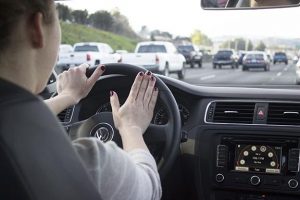
Twenty three percent of upperclassmen claim that they have been the instigator of a road rage interaction, according to the March Bark survey.
In the wake of a recent road rage incident in Corte Madera that resulted in a court case, people have become increasingly aware of the escalation of road rage in Marin.
After a driving altercation during the summer of 2014, Tiburon local Bill Osenton followed doctor James Simon to his house in Corte Madera, which caused Simon to shoot Osenton. As a result, Osenton took legal action. However, Simon was found innocent in January by the Marin Superior Court because it was found to be an act of self-defense.
According to California Highway Patrol (CHP) officer Andrew Barclay, the CHP receives anywhere from six to twelve calls reporting road rage on any given day. Since the beginning of February, Barclay’s CHP division has received more than 300 calls reporting road rage, or what they would classify as “highway violence.”
Barclay also said that the majority of Marin’s road rage incidents begin on the freeway.
“As far as our freeways go, [Marin] is a very transient population, meaning they’re either coming from or going to something,” Barclay said. “A big portion of road rage is impatience. You get someone in a rush to get somewhere and it irritates someone else, and the situation escalates.”
According to Barclay, road rage in Marin differs from that in big cities. In big cities there are more stoplights, which give people the opportunity to get out of their vehicle and confront one another both verbally and physically. In Marin, however, the incidents mainly occur on the freeway.
According to Barclay, people report experiencing road rage for a variety of reasons. A common form of road rage in Marin is “brake-checking,” where a driver swerves in front of another car and brakes.
40.1% of Redwood students report that they have been involved in a road rage interaction.
Junior Maddy Carlin said she has both partaken in and experienced road rage.
“In a lot of merging situations, I get a lot of rage if people don’t let me in or if they cut me off,” she said. “A lot of [the road rage experience] has been when they’ve come into my lane without looking and have come in close proximity to my car.”
Carlin said that she hasn’t experienced any extreme road rage to the point of physical or verbal confrontation. According to Barclay, although it is uncommon, it is possible for the situation to escalate dramatically.
Barclay said that engaging another car with aggressive behavior or intentions can also be dangerous because the other person could have a weapon.
“You don’t know who that other person is,” Barclay said. “You don’t know what they’re doing, what they have in their car, or what they’re capable of. If that person gets out of the car with a gun… you’re outmatched.”
However, road rage is not only physically dangerous. In an email interview, Leon James, co-author of “Road Rage and Aggressive Driving: Steering Clear of Highway Warfare,” said that road rage can also cause stress, meaning that above all physical dangers, it can also cause psychological distress.
James also said that parental influence can be a factor in some people’s propensity for road rage.
“People learn to be aggressive with cars from childhood when they are driven by adults who express verbal road rage yelling and gesturing to other motorists,” James wrote. “The backseat of the car is what I call ‘road rage nursery.’ So when they grow up and start driving, their aggressive emotions learned in childhood come out.”
Barclay and James also speculate that sex could be a factor.
“I would say the majority of the time it’s male drivers,” Barclay said. “I can only think of a handful of occasions that it was a female driver out of the car fighting.
“Either they’re tired or grumpy, and something happens and it gets them mad,” said Barclay. Stress causes road rage and road rage causes stress according to Leon James.
James said that the best way to stay protected from road rage is to be observant while driving, and to be aware of personal mistakes to avoid engaging in a road rage incident.
According to Barclay, the best thing to do when involved in a road rage incident is call 911, state the location, and describe the incident. It’s also important to keep distance from the other car involved, and if the other person is following, one can go to an area with many people or a police station.






